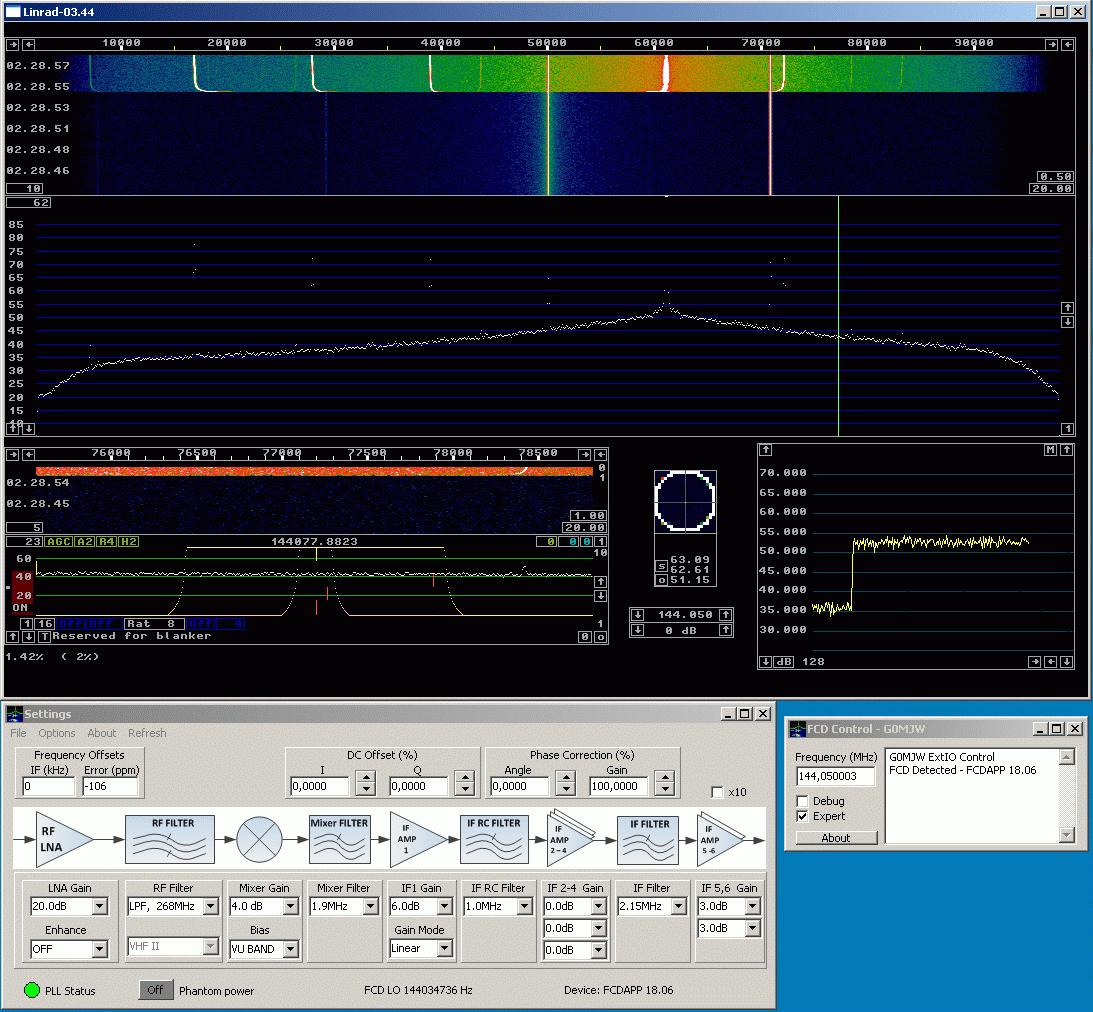The FUNcube USB dongle.
Read about it here: /http://www.funcubedongle.comThis dongle is similar to rtlsdr dongles. It uses a e4000 chip like some of the rtlsdr units do. The analog output from the e4000 chip is sampled with a 16 bit A/D converter which looks like a USB soundcard to Windows. The dongle has a LNA between the e4000 chip and the antenna connector. This LNA allows a slightly better noise figure, but it degrades the dynamic range severely.
Sensitivity and 1 dB compression.
There are many gain controls in the e4000 tuner. Table 1 shows the performance of the dongle at some different settings. The frequency of operation is 144 MHz.
Default NF14.5 NF18 NF11 Best Sensitive NF6.4
LNA(dB) 20 10 7.5 20 30 30 20
Mix(dB) 4 4 4 4 4 12 12
IF1(dB) 6 6 6 3 3 3 3
IF2(dB) 0 0 0 0 0 0 0
IF3(dB) 0 0 0 0 0 0 0
IF4(dB) 0 0 0 0 0 0 0
IF5(dB) 3 3 3 3 3 3 3
IF6(dB) 3 3 3 3 3 3 3
NF(dB) 7.8 14.5 18.0 11.0 7.0 4.8 6.4
MDS(dBm) -139.2 -132.5 -129.0 -136.0 -140.0 -142.2 -140.6
1dBcomp@10kHz (dBm) -52 -43 -40 -47 -49 -56 -51
1dBcomp@100kHz (dBm) -52 -43 -40 -47 -49 -56 -51
1dBcomp@1MHz (dBm) -53 -42 -39 -46 -48 -57 -50
1dBcomp@10MHz (dBm) -48 -38 -34 -45 -46 -51 -47
Dyn.range (dB) 87 89 89 89 91 86 90
Table 1. Noise figure and 1 dB compression dynamic range with
respect to MDS in a bandwidth of 500 Hz.
| |||||||||||||||||||||
|
The noise figure can be made low, but the dynamic range is small so in a real application it might be impossible to use a gain setting that provides a low NF. 3 dB gain compression.Signals within the passband do not saturate the A/D converter, gain compression in the E4000 tuner prevents saturation.Table 2 shows the level required for 3 dB gain compression at offsets of 1, 2 and 10 MHz. The table shows the data for the gain settings giving NF=7.0 and 14.5 in table 1 and compares them to the compression data for rtlsdr which also uses the E4000 tuner. | |||||||||||||||||||
Interference level for 3 dB compression
RTL-SDR FUNcube
NF Offset Offset Offset Offset Offset Offset
1 MHz 2 MHz 10 MHz 1 MHz 2 MHz 10 MHz
(dB) (dBm) (dBm) (dBm) (dBm) (dBm) (dBm)
7.0 -54 S -43 -30 -44 -42 -42
14.5 -41 S -35 -26 -38 -38 -34
Table 2. The signal level that causes 3 dB compression.
At 1 MHz offset the 8 bit A/D converter in the RTL-SDR saturates before compression happens. | |||||||||||||||||
|
It is quite obvious that the performance at wide separations is better for the RTL-SDR. The LNA in front of the E4000 tuner in the FUNcube degrades the dynamic range performance by about 10 dB for signals 10 MHz away from the center frequency. The LNA does allow a slightly better noise figure, but in real world situations it will seldomly be possible to use gain settings that give a noise figure below 7 dB due to overload problems. The LNA is motivated by the poor NF (14 dB) of the first PCB spin for the FUNcube. The manufacturer specifies an NF of 4.5 to 3.8 dB on different frequency bands. The RTL-SDR showed 7 dB NF on 144 MHz in measurements here The real NF of rtlsdr might be a little lower if some care is taken to remove interference from the USB link. Reciprocal mixing.Figures 1 and 2 show the Linrad screen with and without a strong signal that is at the point of 1 dB compression. | |||||||||||||||

| |||||||||||||
| Fig. 1. The noise floor with modest signal at 144.071 MHz. | |||||||||||

| |||||||
| Fig. 2. A signal near the point of saturation lifts the noise floor dramatically at close range. The modest signal at 144.071 MHz is compressed by about 0.1 dB. | |||||
Table 3 shows the noise floor at different distances from the carrier. | |||
Offset Noise floor (kHz) (dBc/Hz) 10 91 50 103 100 108 200 110Table 3. Reciprocal mixing. | |
|
|